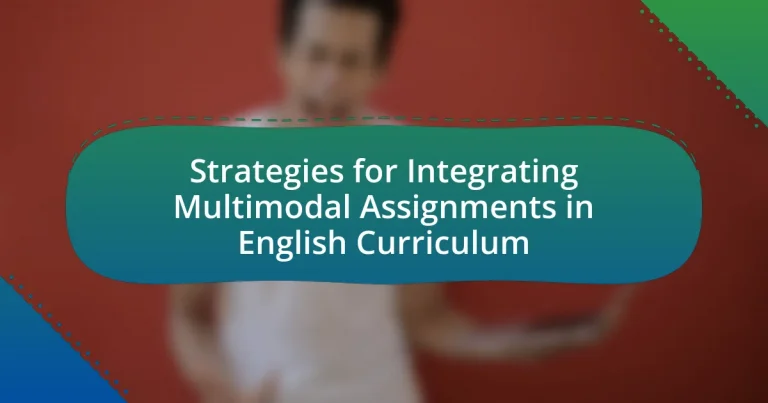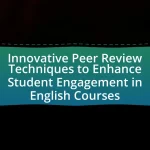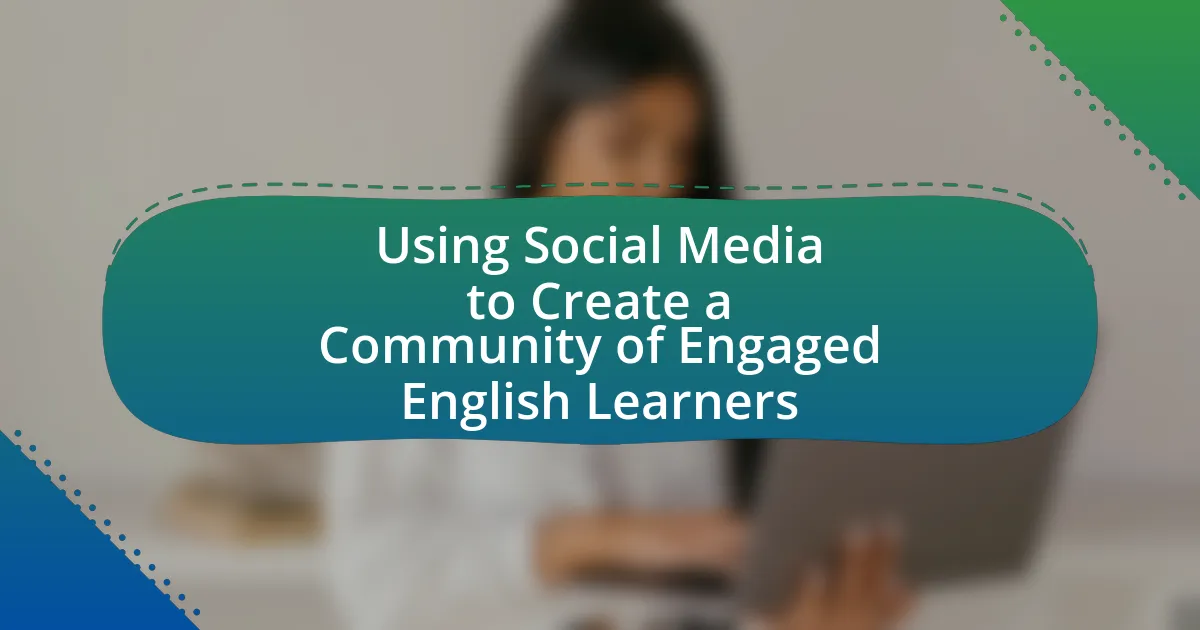Multimodal assignments in the English curriculum involve tasks that utilize various modes of communication, including text, audio, visual, and digital formats, to enhance student engagement and comprehension. These assignments differ from traditional ones by allowing richer expression of ideas and catering to diverse learning styles, thereby fostering critical thinking and creativity. The article outlines the benefits of integrating multimodal assignments, strategies for effective implementation, and considerations for diverse learning styles, while also addressing potential challenges educators may face. Additionally, it discusses the role of technology and collaboration in enhancing the multimodal learning experience, along with effective assessment methods and resources to support integration.

What are Multimodal Assignments in the English Curriculum?
Multimodal assignments in the English curriculum are tasks that require students to engage with multiple modes of communication, such as text, audio, visual, and digital formats. These assignments encourage students to express their understanding and creativity through various media, enhancing their learning experience. Research indicates that integrating multimodal assignments can improve student engagement and comprehension, as they cater to diverse learning styles and promote critical thinking skills.
How do multimodal assignments differ from traditional assignments?
Multimodal assignments differ from traditional assignments by incorporating multiple forms of media and communication, such as text, audio, video, and visuals, whereas traditional assignments typically rely solely on written text. This integration of various modalities allows for a richer expression of ideas and caters to diverse learning styles, enhancing student engagement and understanding. Research indicates that multimodal approaches can improve learning outcomes by fostering critical thinking and creativity, as evidenced by studies showing that students who engage in multimodal projects demonstrate higher levels of comprehension and retention compared to those who complete traditional assignments.
What types of modalities are commonly used in these assignments?
Common modalities used in multimodal assignments include visual, auditory, and kinesthetic elements. Visual modalities often involve images, videos, and infographics to enhance understanding and engagement. Auditory modalities may include podcasts, music, or spoken presentations that cater to auditory learners. Kinesthetic modalities engage students through hands-on activities or physical movement, allowing them to learn through experience. These modalities are effective in addressing diverse learning styles and promoting deeper comprehension in the English curriculum.
Why is it important to incorporate multiple modalities in learning?
Incorporating multiple modalities in learning is important because it enhances engagement and retention of information. Research shows that learners process information more effectively when it is presented through various formats, such as visual, auditory, and kinesthetic methods. For instance, a study by Mayer (2009) in “The Cambridge Handbook of Multimedia Learning” indicates that students who learn through multiple modalities outperform those who rely on a single modality, as diverse approaches cater to different learning styles and preferences. This multimodal strategy not only fosters a deeper understanding of content but also promotes critical thinking and creativity, making learning more dynamic and effective.
What are the key benefits of integrating multimodal assignments?
Integrating multimodal assignments enhances student engagement and learning outcomes. These assignments allow students to express their understanding through various formats, such as text, audio, video, and visuals, catering to diverse learning styles. Research indicates that multimodal approaches can improve retention rates and critical thinking skills, as they encourage students to analyze and synthesize information from multiple sources. For instance, a study by the University of Southern California found that students who participated in multimodal projects demonstrated a 20% increase in comprehension compared to traditional assignments. This integration fosters creativity and collaboration, preparing students for real-world communication demands.
How do these assignments enhance student engagement?
Multimodal assignments enhance student engagement by allowing learners to interact with content through various formats, such as text, audio, video, and visuals. This diversity caters to different learning styles and preferences, making the material more accessible and stimulating. Research indicates that students who engage with multimodal assignments demonstrate higher motivation and retention rates, as they can express their understanding in ways that resonate with them personally. For example, a study by Plass et al. (2014) published in the Journal of Educational Psychology found that students exposed to multimodal learning environments showed improved engagement and academic performance compared to those in traditional settings.
What impact do multimodal assignments have on learning outcomes?
Multimodal assignments significantly enhance learning outcomes by engaging students through various forms of media, which caters to diverse learning styles. Research indicates that such assignments improve comprehension and retention of information, as they encourage active participation and critical thinking. For instance, a study by Hattie (2009) found that incorporating multiple modes of representation can lead to a 0.4 effect size on student achievement, demonstrating a substantial positive impact on learning. Additionally, multimodal assignments foster collaboration and communication skills, as students often work in groups to create projects that integrate text, visuals, and audio elements. This holistic approach not only deepens understanding but also prepares students for real-world applications of their knowledge.
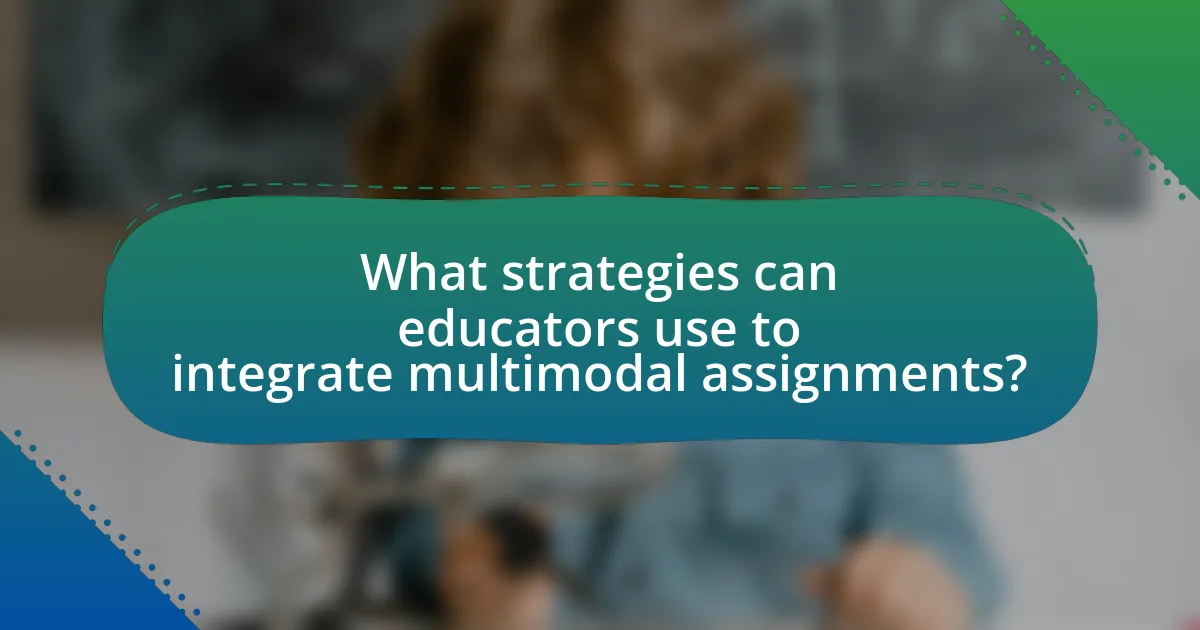
What strategies can educators use to integrate multimodal assignments?
Educators can integrate multimodal assignments by incorporating diverse formats such as visual, auditory, and kinesthetic elements into their curriculum. This approach allows students to engage with content through various mediums, enhancing understanding and retention. For instance, assignments can include creating videos, podcasts, infographics, or interactive presentations, which cater to different learning styles. Research indicates that multimodal learning can improve student engagement and achievement; a study by Hattie (2009) found that varied instructional strategies significantly impact student performance. By utilizing these strategies, educators can foster a more inclusive and effective learning environment.
How can teachers design effective multimodal assignments?
Teachers can design effective multimodal assignments by incorporating diverse formats such as text, audio, video, and interactive elements to engage students and enhance learning. This approach caters to various learning styles and encourages creativity, critical thinking, and collaboration among students. Research indicates that multimodal assignments can improve student engagement and retention of information, as evidenced by a study published in the Journal of Educational Psychology, which found that students who participated in multimodal learning environments demonstrated higher achievement levels compared to those in traditional settings. By integrating these elements thoughtfully, teachers can create assignments that not only meet educational objectives but also resonate with students on multiple levels.
What considerations should be made for diverse learning styles?
Considerations for diverse learning styles include recognizing that learners process information differently, which necessitates a variety of instructional strategies. For instance, visual learners benefit from diagrams and videos, while auditory learners thrive with discussions and lectures. Kinesthetic learners require hands-on activities to engage effectively. Research indicates that employing a multimodal approach can enhance learning outcomes; a study by Fleming and Mills (1992) highlights that integrating multiple modalities caters to individual preferences, thereby improving retention and understanding. Additionally, assessments should be varied to accommodate these differences, allowing students to demonstrate their knowledge in ways that align with their strengths.
How can technology be leveraged in multimodal assignments?
Technology can be leveraged in multimodal assignments by utilizing digital tools that facilitate the integration of various forms of media, such as text, audio, video, and interactive elements. For instance, platforms like Google Slides or Prezi allow students to create presentations that combine images, videos, and text, enhancing their storytelling capabilities. Additionally, tools like Padlet or Flipgrid enable collaborative projects where students can share and respond to each other’s work in diverse formats, fostering engagement and creativity. Research indicates that incorporating technology in multimodal assignments can improve student motivation and learning outcomes, as evidenced by a study published in the Journal of Educational Technology & Society, which found that students who engaged in multimodal projects demonstrated higher levels of critical thinking and creativity.
What role does collaboration play in multimodal assignments?
Collaboration enhances the effectiveness of multimodal assignments by fostering diverse perspectives and skills among participants. When students work together, they can combine their unique strengths, leading to richer content creation and more innovative solutions. Research indicates that collaborative learning environments improve critical thinking and problem-solving abilities, as evidenced by a study published in the Journal of Educational Psychology, which found that students engaged in collaborative tasks performed better academically than those who worked independently. This synergy not only enriches the learning experience but also prepares students for real-world scenarios where teamwork is essential.
How can group projects enhance the multimodal learning experience?
Group projects enhance the multimodal learning experience by fostering collaboration among students, which allows them to engage with diverse learning styles and perspectives. This collaborative environment encourages the integration of various modes of communication, such as visual, auditory, and kinesthetic, thereby catering to different learners’ needs. Research indicates that students participating in group projects demonstrate improved critical thinking and problem-solving skills, as they must negotiate ideas and synthesize information from multiple sources. Furthermore, a study by Johnson and Johnson (2014) highlights that cooperative learning strategies, including group projects, lead to higher academic achievement and greater retention of knowledge, reinforcing the effectiveness of this approach in multimodal education.
What are best practices for facilitating collaboration among students?
Best practices for facilitating collaboration among students include establishing clear goals, promoting open communication, and utilizing diverse group roles. Clear goals provide a shared purpose, ensuring all students understand the objectives of their collaboration. Open communication fosters an environment where students feel comfortable sharing ideas and feedback, which is essential for effective teamwork. Assigning diverse roles, such as leader, note-taker, and presenter, encourages participation from all group members and leverages individual strengths. Research indicates that structured collaboration enhances student engagement and improves learning outcomes, as evidenced by studies showing that collaborative learning can lead to higher academic achievement and better retention of information.
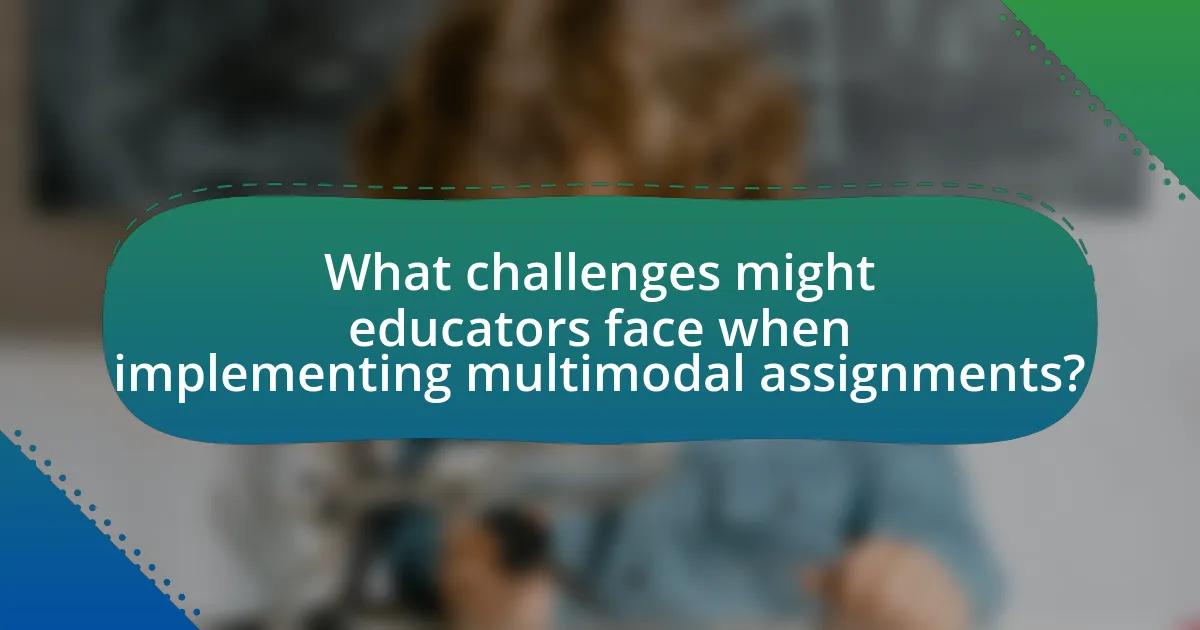
What challenges might educators face when implementing multimodal assignments?
Educators may face several challenges when implementing multimodal assignments, including resource limitations, varying student skill levels, and assessment difficulties. Resource limitations can hinder access to technology and materials necessary for creating diverse content formats, which is essential for multimodal assignments. Additionally, students may possess different levels of proficiency in various modalities, such as visual, auditory, or kinesthetic, complicating the teaching process. Assessment difficulties arise from the subjective nature of evaluating multimodal work, as traditional grading rubrics may not adequately capture the effectiveness of diverse presentation styles. These challenges can impede the successful integration of multimodal assignments into the English curriculum.
How can teachers overcome resistance to multimodal assignments?
Teachers can overcome resistance to multimodal assignments by providing clear guidelines and demonstrating the value of these assignments in enhancing student engagement and learning outcomes. Research indicates that multimodal assignments cater to diverse learning styles, which can increase student motivation and participation. For instance, a study by the National Education Association found that integrating various modes of communication, such as visual, auditory, and kinesthetic elements, leads to improved comprehension and retention of material. By showcasing successful examples and offering support throughout the assignment process, teachers can alleviate concerns and foster a more positive attitude towards multimodal learning.
What strategies can be employed to address resource limitations?
To address resource limitations, educational institutions can implement strategies such as prioritizing digital resources, fostering community partnerships, and utilizing open educational resources (OER). Prioritizing digital resources allows for efficient use of existing technology and materials, enabling access to a wider range of learning tools without significant financial investment. Community partnerships can provide additional support and resources, such as guest speakers or shared facilities, enhancing the educational experience without incurring extra costs. Utilizing OER, which are freely accessible and openly licensed materials, can significantly reduce expenses associated with traditional textbooks and resources, as evidenced by a study from the University of Georgia that found a 50% reduction in costs for students using OER. These strategies collectively help mitigate the impact of limited resources in educational settings.
What assessment methods are effective for multimodal assignments?
Effective assessment methods for multimodal assignments include rubrics, peer assessments, and self-assessments. Rubrics provide clear criteria for evaluating various components of multimodal projects, ensuring consistency and transparency in grading. Peer assessments encourage collaboration and critical thinking, allowing students to engage with each other’s work and provide constructive feedback. Self-assessments promote reflection, enabling students to evaluate their own learning and identify areas for improvement. Research indicates that these methods enhance student engagement and learning outcomes by fostering a deeper understanding of the material and encouraging diverse forms of expression.
How can rubrics be adapted for multimodal evaluation?
Rubrics can be adapted for multimodal evaluation by incorporating criteria that assess various modes of communication, such as visual, auditory, and textual elements. This adaptation involves defining specific performance indicators for each mode, ensuring that the rubric reflects the diverse skills required for multimodal assignments. For instance, a rubric can include categories for visual design, clarity of spoken presentation, and coherence of written content, allowing for a comprehensive evaluation of student work. Research indicates that using multimodal rubrics enhances student engagement and provides clearer feedback, as it aligns assessment with the varied ways students express understanding (Harris, 2020, “Multimodal Assessment in Education,” Journal of Educational Research).
What feedback mechanisms are most beneficial for students?
Timely and specific feedback mechanisms, such as formative assessments and peer reviews, are most beneficial for students. Formative assessments provide ongoing insights into student understanding, allowing for adjustments in teaching methods. Research by Hattie and Timperley (2007) indicates that feedback that is specific, timely, and actionable significantly enhances student learning outcomes. Peer reviews foster collaborative learning and critical thinking, as students engage with each other’s work and provide constructive criticism. These mechanisms not only improve academic performance but also promote self-regulation and motivation among students.
What are some practical tips for successfully integrating multimodal assignments?
To successfully integrate multimodal assignments, educators should ensure clear objectives that align with learning outcomes. Establishing specific goals helps students understand the purpose of using various modes of communication, such as visual, auditory, and textual elements. Additionally, providing students with a variety of tools and resources, such as digital platforms and multimedia software, enhances their ability to create diverse content. Encouraging collaboration among students fosters peer learning and allows for the sharing of different perspectives, which enriches the assignment experience. Lastly, incorporating formative assessments throughout the process allows for ongoing feedback, helping students refine their work and understand the multimodal approach better.
How can educators ensure alignment with curriculum standards?
Educators can ensure alignment with curriculum standards by systematically mapping their instructional goals to the established standards. This process involves reviewing the curriculum standards to identify key learning objectives and then designing assessments and instructional activities that directly address those objectives. Research indicates that when educators utilize backward design, starting with the end goals in mind, they create a more coherent and aligned curriculum. For example, a study by Wiggins and McTighe in “Understanding by Design” emphasizes the importance of aligning assessments with learning outcomes to enhance student understanding and achievement.
What resources are available to support multimodal assignment integration?
Resources available to support multimodal assignment integration include digital tools, instructional guides, and professional development programs. Digital tools such as Google Slides, Canva, and Padlet facilitate the creation of multimedia presentations, while instructional guides provide frameworks for designing effective multimodal assignments. Professional development programs, like those offered by the International Society for Technology in Education, equip educators with strategies to implement these assignments effectively in the classroom. These resources collectively enhance the integration of various modes of communication, fostering a richer learning experience.
